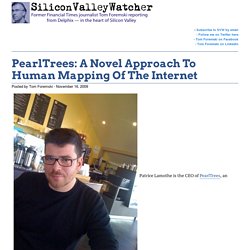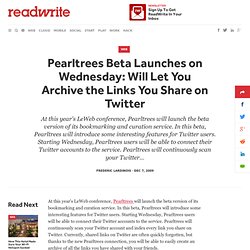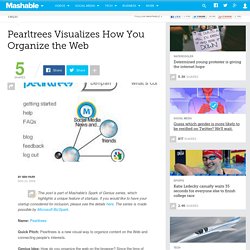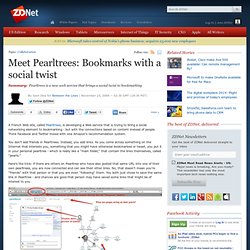

It's not often anymore... Scoble's interview. Foremski's post. Posted by Tom Foremski - November 16, 2009 Patrice Lamothe is the CEO of PearlTrees, an unique social bookmarking service that uses the visual metaphor of "pearls" with each containing a web page.

And like all visual metaphors it is best to see it rather than read a description. Here is a quick video and a sample image: "PearlTrees is a way for people to map the Internet by collecting related web pages. Although each tree is organized subjectively it becomes connected to other trees, and over time it will represent a human map of the Internet," says Mr Lamothe. He says that social bookmarking, through services such as Delicious, has failed. Social bookmarking has failed, he says, because tagging links is not a good way to organize the web.
The company has several thousand users in France and will formally announce the service in the US around February. Mr Lamothe says that a high percentage of users are women, and many users aren't geeks. Revenue could come from several sources. RWW. At this year's LeWeb conference, Pearltrees will launch the beta version of its bookmarking and curation service.

In this beta, Pearltrees will introduce some interesting features for Twitter users. Starting Wednesday, Pearltrees users will be able to connect their Twitter accounts to the service. Pearltrees will continuously scan your Twitter account and index every link you share on Twitter. Currently, shared links on Twitter are often quickly forgotten, but thanks to the new Pearltrees connection, you will be able to easily create an archive of all the links you have shared with your friends. We got a chance to discuss Pearltrees and its upcoming launch with the company's CEO Patrice Lamothe in the startup's Paris offices today. Thanks to the new Twitter feature, which will put all of the links you share on Twitter into a drop box on Pearltrees, you can now easily create a complete archive of all the content you share.
Also Coming This Week: Real-Time Updates API Coming Soon. Mashable. This post is part of Mashable's Spark of Genius series, which highlights a unique feature of startups.

If you would like to have your startup considered for inclusion, please see the details here. The series is made possible by Microsoft BizSpark. Name: Pearltrees Quick Pitch: Pearltrees is a new visual way to organize content on the Web and connecting people's interests. Genius Idea: How do you organize the web on the browser? Signing up for Pearltrees is simple, but getting used to the interface and all of its features is not as easy. Now for the organization part: you can create complex systems of pearls, known as pearltrees. Clicking on a pearl gives you a range of options that go beyond visiting your favorite website. Pearltrees takes a time investment to make it useful. FastCompany.
Social bookmarking sites such as StumbleUpon or Delicio.us are great for finding interesting, quirky content.

But the hunt is on for something better. One example: The just-launched PearlTrees, which allows you to lump and organize your links into network graphs. The best bit is that when you create a node in your network (a "pearl"), you can see who else has bookmarked that same link--and see what they've tagged as related content. A short video explains: You might have noticed that startups like these are reaching a fever pitch--In recent weeks we've seen this Twitter visualization tool and Nebul.us, which does much of the same work as PearlTrees, with a more robust (albeit complex) visualization system. The logic seems hard to fight: Think about how easy it is to get lost in all the content flying around on Digg or Stumble Upon. The question is: Who can build their network the fastest? [Mashable via Infosethics] ZDnet. A French Web site, called Pearltrees, is developing a Web service that is trying to bring a social networking element to bookmarking - but with the connections based on content instead of people.

Think Facebook and Twitter mixed with one Amazon's recommendation system. You don't add friends in Pearltrees. Instead, you add links. As you come across something on the Internet that interests you, something that you might have otherwise bookmarked or tweet, you put it in your personal pearltree - which is really like a "main folder," that contain the links themselves, called "pearls. " Here's the trick: if there are others on Pearltree who have also posted that same URL into one of their own pearltrees, you are now connected and can see their other links.
The service, which is free, is still in alpha mode and has limited functionality and exposure. For now, it's a bit buggy but the concept is pretty solid. CCN: the Web's next big thing? Official baunch at LeWeb09.